The opulent Opéra de Paris Garnier was designed by Charles Garnier for Emperor Napoleon III as the main opera house in Paris. It is the most important symbol of the eclectic late nineteenth-century architectural style known as Second Empire.
History
Opéra Le Peletier
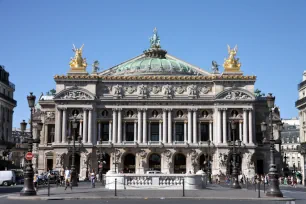
In the mid-nineteenth century, the opera house of Paris was the Opéra Le Peletier, located on the narrow Le Peletier Street in the 9th arrondissement. This opera house was originally built in 1820 as a temporary venue: in response to the assassination of the Duke of Berry in front of the opera house in the Richelieu Street, King Louis XVIII had ordered the immediate demolition of the opera house, so a temporary building was constructed in the Le Peletier Street.
History almost repeated itself in 1858 when Emperor Napoleon III survived an assassination attempt in front of the opera house in the Le Peletier street that resulted in eight dead and more than one hundred wounded. The emperor concluded that the street was too prone to attacks and decided to construct a new opera house nearby facing a large open square. This time the old opera house was not demolished, but a fire destroyed it in 1873, shortly before the new opera house was completed.
A new opera house
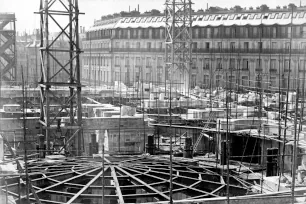
An architectural competition for this new opera house was won in 1861 by Charles Garnier, at the time a young and relatively unknown architect. He created an opulent design in the eclectic Second Empire style. The design was so successful that it would come to represent the epitome of the Second Empire style.
Construction started in 1861 even though the first stone was only laid the following year. Progress was slow due to the marshy conditions of the terrain and the high water table. A casing was created to redistribute the weight of the building that resulted in a ‘lake’ below the opera house that was the inspiration for the hiding place of the «Phantom of the Opera» in Paul Leroux’s famous novel.
Construction dragged on for years due to financial difficulties. More delays were caused by the war with Prussia in 1870 which resulted in the fall of the Second Empire and the tumult during the Commune of Paris (a revolutionary government). Emperor Napoleon III was able to inaugurate the front facade of the opera house in 1867, but it would take another eight years before the whole opera house was officially completed. By that time the Second Empire had fallen and Napoleon III dethroned.
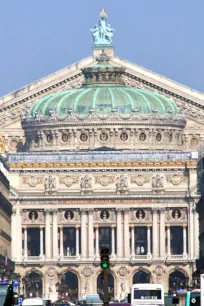
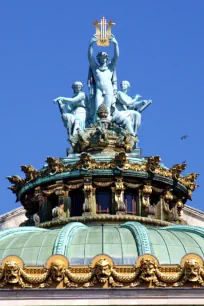
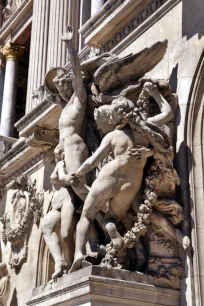
The Building
Even though the opera house has a seating capacity of less than 2,200, the building is one of the largest theaters in the world – and the largest of its time – with a total surface area of 58,000 square meters (624,000 square feet).
The building measures 172 meters in length, 101 meters in width and reaches a height of 79 meters (564 x 331 x 259 feet). Garnier used modern materials such as iron floors, beams, and vaults for the structural integrity of the building, but he did not like the appearance of those materials so he hid them behind plenty of marble, plaster, stucco, bronze and gilded ornaments, as well as an abundance of sculptures.
Exterior
The exterior is defined by its imposing colonnaded front facade, behind which sits the large foyer. Over the facade looms the beautiful copper-green dome, which rises above the auditorium. The triangular pediment behind the dome marks the site of the spacious stage area. The assassination attempt on Napoleon III’s life in 1858 in front of the former opera house led to the construction of a ramp on the west side of the building that allowed the emperor to walk straight from his carriage into the royal box.
The opera house is adorned with numerous sculptures created by seventy-three sculptors. Both the interior and exterior feature numerous statues.
The base of the front facade, facing a large square, is adorned with four allegorical sculpture groups representing «Poetry», «Music», «Dance», and «Drama». They were created by four different sculptors. The facade is surmounted by two gilded sculpture groups, each 7.5 meters tall (25 feet). They are the work of Charles Gumery and show the allegorical figures of «Harmony» (left) and «Poetry» (right).
The pediment is crowned by an equally large sculpture group that shows Apollo holding aloft his lyre. He is flanked by allegorical representations of «Music» and «Poetry». The sculpture group, which weighs a massive thirteen tonnes, also serves as a lightning rod. It was created between 1860 and 1869 by Aimé Millet. Two identical equestrian statues adorn either side of the pediment. They depict «Renown holding back Pegasus» and were created by Eugène-Louis Lequesne.
Interior
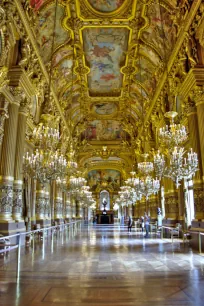
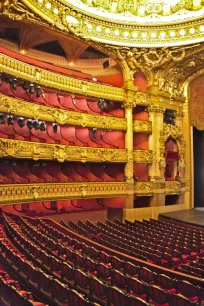
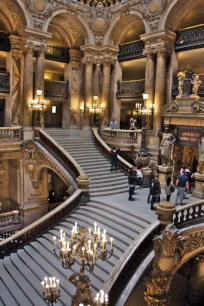
The interior of the Opéra Garnier building is even more impressive than its exterior. The opulence of the 54-meter-long Grand Foyer – the main hall where visitors gathered before the opera and during intermissions – recalls the grandeur of the Palace of Versailles. Gold leaf is everywhere. Corinthian pilasters and huge chandeliers hang from the ornate ceilings, decorated with ornaments and large paintings. The walls are lined with massive Corinthian columns whose architraves support gilded statues of muses.
Visitors reached the Grand Foyer by climbing the steps of the Grand Staircase, a grandiose white marble staircase with two flights and a height of 30 meters (98 feet). Its balustrade is made of green and red marble. This magnificent staircase served as the model for the marble staircase in New York’s Grand Central Terminal.
Between the Grand Staircase and the Grand Foyer is the Avant-Foyer, another beautiful hall with vaulted ceilings decorated with mosaics and – yet again – lots of gold leaf.
Below the green copper dome is the auditorium which seats about 2,000 and is decorated with red velvet, plaster cherubs and more gold leaf. The original ceiling painting by Jules-Eugène Lenepveu, called «The muses and the hours of day and night» is now hidden behind a painting created in 1964 by Marc Chagall. From its center hangs a spectacular chandelier that weighs a massive six tonnes. The stage area is the largest in Europe: it is 60 meters high (197 feet) and has room for up to 450 actors.
Palais Garnier
The Opéra Garnier was originally simply known as the Opéra de Paris. But with the construction of the modern Opéra de Paris Bastille on the Place de la Bastille in 1989, the majestic Garnier Opera has been replaced as Paris’s main opera venue. The latter is now officially known as Palais Garnier, and mainly used for ballet performances, although occasionally you can still watch an opera performance here.
Location
The Opera de Paris Garnier is located at the Place de l’Opéra, a square in the 9th arrondissement, just north of the 2nd arrondissement. The best way to get there is by taking metro line 3, 7, or 8 to the Opéra stop that sits in the middle of the Place de l’Opéra. To visit the opera house, walk to the west side of the building; the entrance is behind one of the two ramps. Check the opening hours on the official site.

